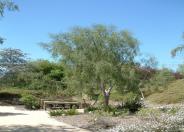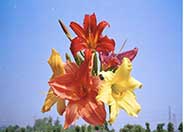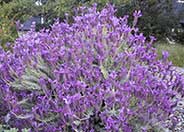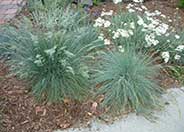
Common name:Australian Willow
Botanical name:Geijera parviflora
Australian Willow (Geijera parviflora) is an excellent specimen tree for medium-sized gardens. This Australian native tree reaches 45’ tall and 20’ wide and is very low-water-use and low maintenance. These trees can be found in nurseries in both single-trunk and multi-trunk forms. The natural growth habit is weeping and irregular, so it does require some selective pruning and shaping when young to achieve the desired look. Thinning out the heavy, weeping branches will take some of the weight out of them, and they usually lift. The tree may require this type of pruning a few times a year for the first two or three years, but once it has achieved a height requiring a ladder to prune, it should be shaped by a licensed arborist. This tree is a slow grower and would benefit from an application of nitrogen fertilizer every year. It should be planted at least four feet away from any hardscape areas, 15 feet from structures such as houses and buildings, and not near any powerlines. Shrubs and perennials should be planted about three feet away from this tree. It should be irrigated for about 45 minutes once a week when using most in-line drip irrigation systems.

Common name:Daylily (hybrid selection)
Botanical name:Hemerocallis hybrids
These summer-blooming perennials form clumps with large, grass-like leaves. Its showy flowers, resembling lilies, are borne in clusters on stems held well above the foliage. Daylilies can be found in many colors: yellow, orange, red, purple, pink or multi-colored. Hemerocallis does better in well-draining soil and with extra summer water. Hemerocallis are very hardy,with few or none pests/problems.

Common name:Spanish Lavender
Botanical name:Lavandula stoechas
This dense shrub grows 2'-3' tall with blue gray foliage and deep purple flowers that have large showy bracts near the top of the spikes. It is drought tolerant .

Common name:Blue Fescue
Botanical name:Festuca glauca
This ground cover/grass will grow less than 1' tall and has small, blue green leaves.
Maintenance Tips
Festuca glauca is a perennial clump-forming grass. It has soft straw-like leaves that form a blue-green dome that can get up to about 10 inches wide and tall. They prefer full sun and well-drained soil, but can tolerate slight shade, drought conditions, and poor soil nutrition. These will send out flower stalks in the summer, which should be cut back to the base after a few months to give them a cleaner appearance. They will also benefit from having any dead leaves pulled from the plant at any time of year, but the fall is typically the best time to clean up the foliage. It is short-lived in the landscape, with a lifespan of about 2-4 years after which it dies out in the center. Some might dig up and divide the living edges into several new plants, but most of the time it is easier to replace with a new one.Designer: Rob Moore
Photographer: GardenSoft
Practice grass-cycling by leaving short grass clippings on lawns after mowing, so that nutrients and organic matter are returned to the soil.
Adjust sprinklers to avoid watering sidewalks and driveways.
Attract, or buy beneficial insects such as ladybugs and lacewings to control pest outbreaks in your garden.